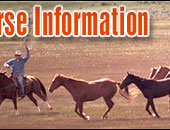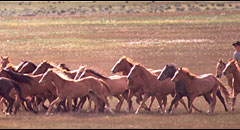 |
   |
|
|
|
You are here: Horses > Horse diseases > Equine arthritis signs |
Signs of Horse Arthritis and Degenerative Joint
Disease (DJD)
The best way of preventing crippling degenerative joint
disease (DJD) and arthritis in horses is to detect the signs
early. However, the earliest signs of joint problems are
subtle. Owners must look for signs such as mild swelling and
heat in the joint, rather than the lameness that accompanies
more advanced cases. |
|
|
There are some other early warning signs of equine
arthritis. Changes in behavior or performance, such as a new
reluctance to change leads, run barrels, set a steer or take
jumps, can signify the onset of early joint disease.
While all horses have some risk of developing joint problems
and DJD, there are several factors that owners should be
aware of that increase a horseís risk. |
A horse with crooked legs or who toes in or toes out places
uneven pressure on its joints. For example, a horse who toes
out experiences greater pressure on the inner aspect of the
coffin, pastern, fetlock and knee joints than on the outer
side. This uneven pressure predisposes the joints to
inflammation and soft tissue damage, as well as uneven wear
on the cartilage. This can lead to DJD.
Also, just like in humans, older horses are more prone to
arthritis. From birth until the age of two, a horseís joints
grow cartilage more quickly than it can be worn away. This
growth rate slows after the age of two until it is roughly
equal to the rate of normal wear. After the age of fifteen,
however, the wear and tear on cartilage begins to outpace
the rate of its replacement.
This results in a general thinning of cartilage, which
increases the impact between bones and results in greater
risk of joint injury. Also, the tendons and ligaments lose
elasticity as horses age. This increases their
susceptibility to tears, and can cause joint instability and
increase inflammation.
Since all joints and all horses are unique, and their
response to injury is slightly different, early signs of
joint problems can be hard to spot. The earliest signs are
usually heat or swelling of the affected joint, pain when
the joint is flexed, and various degrees of lameness.
When your veterinarian examines your horse, he will usually
observe it trotting both in a straight line and in circles
on a hard surface. He may also use local anesthesia for
nerve blocks, as well as x-rays, ultrasound, and take joint
fluid samples for analysis. He may also want to perform an
arthroscopic examination, which involves the insertion of a
tiny flexible scope into the joint to look for damage.
Once your vet has determined which joints are affected, he
will usually order additional x-rays to help determine the
severity of the damage. This will also rule out other joint
disorders and injuries, such as fractures, loose bone
fragments, or foreign bodies.
 |
Read the next horse diseases article on Arthritis Treatments for Horses. |
|
|
|
|
 |
|
|
|
|
|
Horse Education
|
|
|
|
|
Horse Information Topics
|
|
|
|
|
|
|
|
Horse Business Owners
|
| |
Advertise with Us
Have your horse products or services exposed to over 27,000 of our monthly visitors.
|
|
|
|
|
|